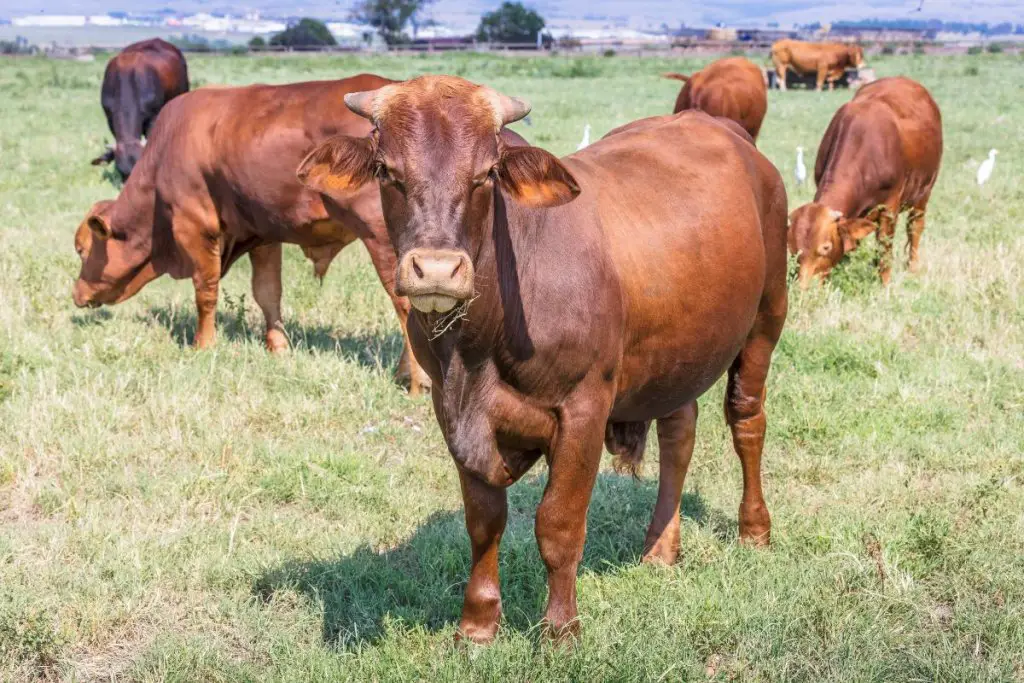Excellent for new farmers, Beefmaster cattle are in wide use in several countries, and has been proven to produce quality cuts, exceptional milk, and a gorgeous hide. They are approximately 50% Brahman, 25% Hereford and 25% Shorthorn.
Beefmaster Cattle are a dual-purpose American composite breed that was specifically bred to be a high performer and has been given the moniker “The Profit Breed”.
Table of Contents
Where Does Beefmaster Cattle Come From?
In 1908, Ed Lasater, a cattleman, began a composite program in South Texas to produce a dual-purpose cattle breed that was suited for commercial use as both a meat and milking breed. Profitability was the cornerstone of what he set out to achieve.
Yet, it ultimately was his son Tom Lasater who refined the Beefmaster breed and is credited with its creation.
Tom listed out six essential traits that he believed are required in order for beef production to be profitable for ranchers:
- Weight
- Conformation
- Hardiness
- Disposition
- Fertility
- Milk production
His Beefmaster cattle met the requirements for all six.
It is believed that three main types of cattle were combined to create Beefmaster cattle, including Brahman cattle, Hereford cattle, and Shorthorn cattle. Other breeds were introduced briefly at different times including Gir and Nelore in the early days of the program, and Guzerat, which Lasater added in 1952.
While the exact percentages aren’t known, most people believe that the Beefmaster breed gets roughly half of its genetics from Brahman cattle, and the remaining 50% is split evenly between Hereford and Shorthorn cattle.
Using the best examples of each breed guarantees heterosis when crossbred, which can be seen in other composite breeds such as the Brangus (half Angus and half Brahman) which is well known for highly vigorous calves.
Beefmaster cattle were recognized as a breed by the USDA in 1954. They have gone on to be one of the most widely used American cattle in the United States, and have been exported to South Africa, Brazil, and other countries.
Four different breed associations exist for Beefmaster Cattle:
Beefmaster Breeders United (BBU)
Western States Beefmaster Breeders Association
National Cattleman’s Beef Association
Beefmaster Cattle Breed Characteristics
| Official Breed Name | Beefmaster Cattle |
| Scientific Name | Bos taurus indicus |
| Origin | United States |
| Appearance | Well-muscled, polled breed with excellent conformation A rich reddish-brown colored coat that is usually solid in color May have light or white mottling on their faces Known for thick necks and legs, and tight dewlap |
| Calf Weight | 77lbs |
| Mature Cow Weight | 1760lbs |
| Mature Bull Weight | 2600lbs |
| Ready To Breed | 13 to 15 months |
| Gestation Period | 279 to 287 days |
| First Calvings | Around 2 years |
| Time to Slaughter | 12 to 18 months |
| Carcass Weight | 632lbs |
| Expected Lifespan | 11 years |
| Known For | Highly profitable beef cattle Milk production Leather goods |
| Weaknesses | Lack of color uniformity Pendulous sheaths |
| Climate | Adaptable to both cold and hot climates |

What Is So Special About Beefmaster Cattle?
Beefmaster cattle are a true American dual-purpose breed that were bred for qualities of temperament and productive value rather than color or size.
One of the most well-known beef breeds in America, Beefmaster cattle are known for high-quality carcass traits with lean meat that is full of flavor and marbling.
Beefmaster hot carcass weight averages 632lbs and has a ribeye area of 11.51 square inches. The Warner-Bratzler Shear Force average for the Beefmaster breed is 7.47.
Roughly 72% of Beefmaster carcasses grade as Prime or Choice. Yield Grades of 1 or 2 are given on approximately half of all cuts.
Beef is the number one use for Beefmaster cattle, though milk productivity is the second most important trait of all six essentials according to Tom Lasater.
Beefmaster cows produce 1 to 1 and a half gallons of milk per day. This milk is suited for drinking, cheesemaking, and use in other dairy products, yet it is most often used strictly for growing calves quickly.
Cows produce a heavy calf each year and are able to fully support growth and development through the rich milk she provides.
Why Should I Raise Beefmaster Cattle On My Farm?
- Great breed for novice farmers for ease of management
- Beefmaster cows make excellent mothers
- A reasonable birth weight allows for easy calving
- Beefmaster calves have a higher weaning weight than other beef breeds at an average of 520lbs
- No known health issues and high disease and insect resistance
- Beefmaster cattle rarely get pink-eye
- Docile temperament that is easy to handle
- Can handle a wide range of climates and environments but do exceptionally well in hot climates due to bos indicus blood
- Beefmaster cattle have desirable skin that is widely used in the leather industry
- Beefmaster bulls used in crossbreeding add growth and efficiency throughout production increasing profitability
- Calves are high-performing, vigorous, and gain weight readily
- Beefmaster cows lower costs due to less input at cow/calf level of production
- Steers put on weight easily, with the average yearling weight being 866lbs
